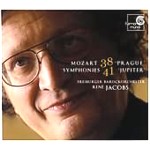From the opening moments of the “Prague” symphony you realize that this is not your father’s Mozart. The orchestral texture is see-through; the Freiburg Baroque Orchestra is made up of only 35 players, and every instrument can be clearly heard. Mozart’s piano concertos are often spoken of as being operatic; indeed, with Jacobs at the helm of these symphonies, much the same might be said. Give and take between orchestral sections seems conversational, and the busy, remarkable fugue that closes the “Jupiter” is so clear that it might well be the finale of the second act of Figaro. The tempos throughout sound very fast, but for the most part they are not–at least by current standards. Jacobs’ way of articulating each new phrase gives the symphonies a feeling of briskness and even flamboyance. And the fact that within movements the sections notated to be taken more quickly are dramatically sped up keeps the whole experience alive and the listener fascinated.
Jacobs embraces the odd chromaticism and combination of timbres in the Andante with relish. Every so often he goes surprisingly wild: the symphony’s final movement is startlingly fast. The opening string figures are impeccably articulated and offered in miniature, and then the movement takes off like the proverbial bat out of hell, the flutes’ figures whizzing by but spotlessly played. It’s just the exhilarating experience it ought to be.
And when it comes to being operatic, I suspect that the first movement of Symphony No. 41 is a little opera of its own. It has true dramatic flair, with sudden variations in dynamics, fierce use of timpani (and none are “thwappier” than those in a “period” orchestra), surprising rhythmic thrusts, and hairpin mood changes. Each trill is audible in whatever instrumental section is playing it; they act as commentary.
Jacobs occasionally exaggerates in-the-score notations, turning the experience into “pimp-my-Mozart”, but you’ll either like it or you won’t. Small embellishments also show up in thematic repeats in the woodwinds and strings and they are most welcome. The slow movement is not quite as songlike as I’d prefer, but the darker moments are well underlined, and when the brass make their statements (at 7:33) you sit up and notice. The third-movement Minuet dances, but not as the minuet we know; it swings here at a tempo much faster than the marked “allegretto”. The joys of the glorious, famous finale are allowed to unfold at a sensible pace, but while all is clear, clean, and spontaneous, somehow the overall effect of the movement lacks the power to overwhelm; it may be that the trees are so clear that the forest loses its mystery. (Or it may just need another 10 string players.)
Jacobs takes all of Mozart’s repeats, but changes the temperature or adds something new in each one so that nothing is by rote. The sound is excellent. These may not replace the Bruno Walter performances on Sony, but they can walk side by side, albeit in an alternate universe. [5/2/2007]
































